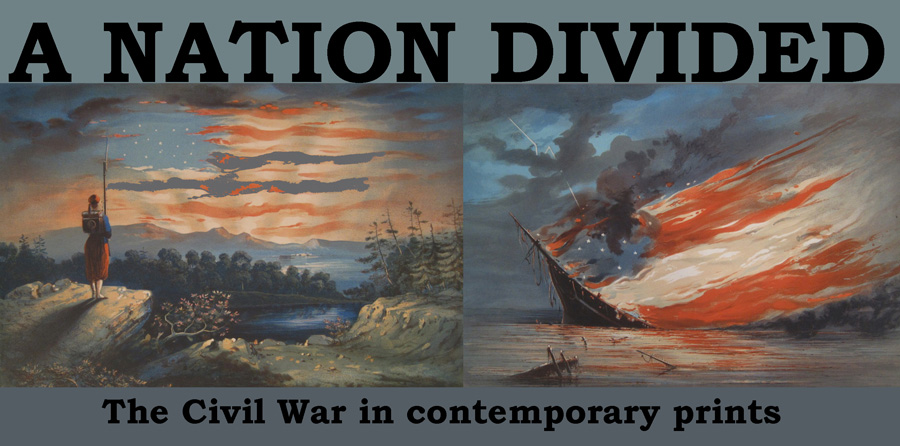
|
|
 |
|
|
|
|

[ Introduction | A Nation Divided web site | Main Index | Civil War Reference Books ]
![]()
The Civil War took place at a time when two significant historical trends combined to make the relevance of prints particularly important. First was the development, in the nineteenth century, of a growing percentage of the American population which both was literate and had an interest in and the wealth to afford books, magazines, newspapers, and prints for the home. The other trend was the development of printmaking processes that allowed for the relatively inexpensive production of large numbers of printed pictures and maps.
The first American public high school was established in Boston in 1821, and this was followed, especially in the 1840s, with the growth of the movement for "common school" public education. At the same time, this was a period of the expansion, especially in the North and Mid-West, of jobs which provided non-elite workers with both leisure time and extra income. This development allowed more and more Americans to indulge their interests in reading and learning about the wider world. A national system of book, magazine, and newspaper distribution fed the growing appetite for these works among the general American public.
The American public wanted not just texts, but also images to complement their reading. Today we have phones which take photographs, televisions in every room, thousands of glossy magazines and coffee-table books, and access to a seemingly never ending stream of images on our computers. In the first few decades of the nineteenth century, pictures of any sort were a rare item in the lives of most Americans; paintings were scarce and owned by the elite, newspapers were mostly text with a few stock images, and prints for decoration were a luxury only the wealthy could afford. It is not unlikely that early in the century, the number of pictures that the average member of the general public saw in a life-time was less than the average member of today's general public sees in one day.
There was clearly a pent-up demand by the general public for pictures of their world. There was a latent interest in seeing images of major events, important figures, views of distant parts of the country and world, and just images of what was going on elsewhere. The development of two important methods of printmaking in the nineteenth century allowed for the production of the thousands of printed images which would satisfy this demand.
Lithography, invented at the end of the eighteenth century, allowed for the efficient and relatively inexpensive production of large numbers of prints. Lithography was brought to America early in the nineteenth century, and by the 1830s there appeared publishers in a number of American cities who produced affordable, lithographed prints intended for the general public. These "popular" prints covered any topic which the publishers thought the public would have an interest in, they were inexpensive and often colorful, and they began to appear ubiquitously in the homes and work places of Americans of all classes.
Wood engraving was a printmaking process with a longer history, but it was refined in the early nineteenth century and developments were made which allowed the printing of thousands of wood-engraved images at reasonable costs. Wood engraving had the particular advantages that the material used was relatively inexpensive and easily worked, and, being a relief process, the images could be printed on the same press and on the same sheets as text type-face. In Europe in the 1840s, this led to the development of the illustrated newspaper, a medium which appeared in America the following decade, soon becoming the most common vehicle for printed images in the lives of the American public.
Thus it is that we believe the study of contemporary printed images of the Civil War is crucial to gain insight into that traumatic event in our nation's history. Not only do these pictures show us today what those people, places and events looked like (although not by any means always accurately), but also it is only through an awareness of these prints that we can gain any true understanding as to how Americans of the time saw the war.
A Nation Divided web site
The intent of this web site is to explore contemporary printed images of the Civil War. We will put up pages on general topics, such as portraits, cartoons, etc., but a main part of the web site will be a monthly account of the events of the war 150 years ago, with a consideration of the prints showing those events.
This web site is intended both as a reference source for those interested in these topics, but also as a sales tool for our shop. Thus we will include images and descriptions of prints and maps we have in our inventory, but also of images which are important to the topic at hand, even if we do not have them for sale. We will list prices for those prints we have in stock, and include links to further lists of 'for sale' prints. If no price appears, then the print is not available, though we would be happy to keep any 'wants' on file if there is an image you are particularly interested in.
We welcome comments and corrections. As historians and printsellers, there are few subjects as important to our work as the prints of the Civil War and we would love to spread knowledge of and interest in this fascinating subject.
![]()
![]()
For further information, please contact:

![]()
106 E. Lancaster Avenue, Lower Level
Wayne, PA 19087 USA
610.808.6165
PhilaPrint@PhilaPrintShop.com ![]()
©The Philadelphia Print Shop 2021